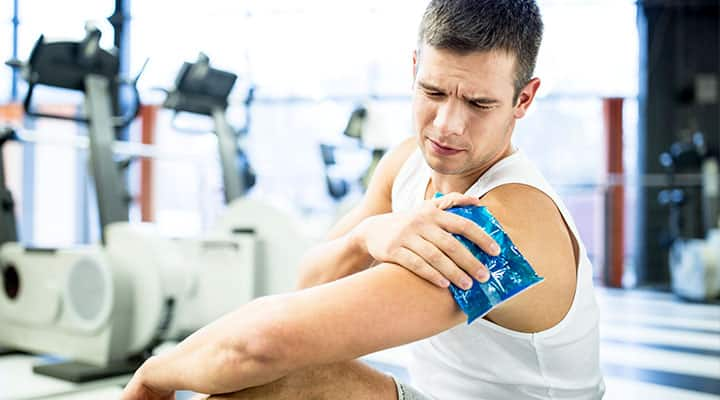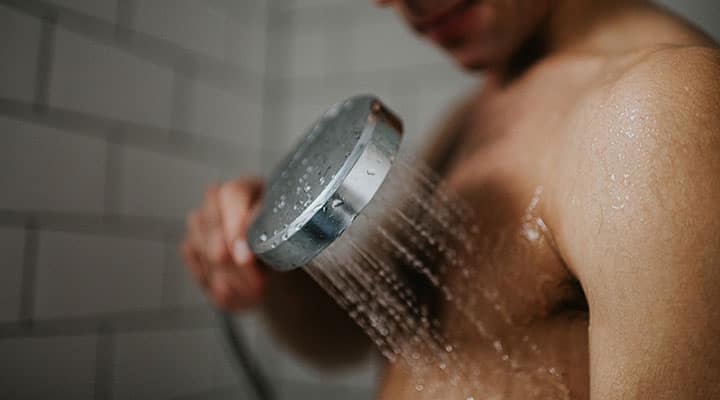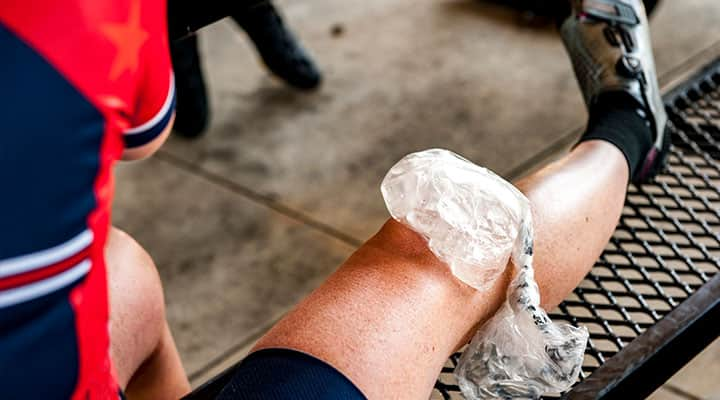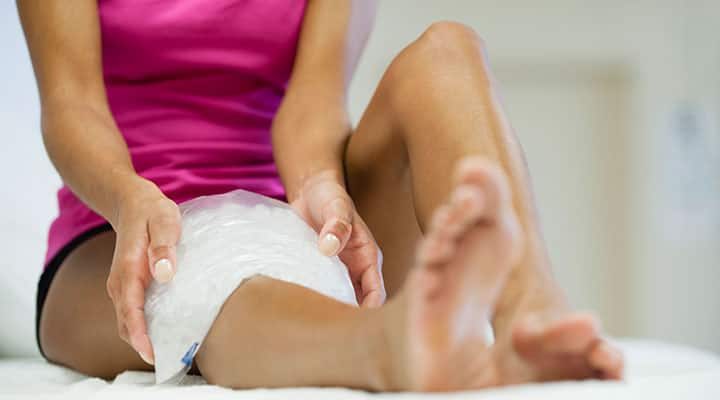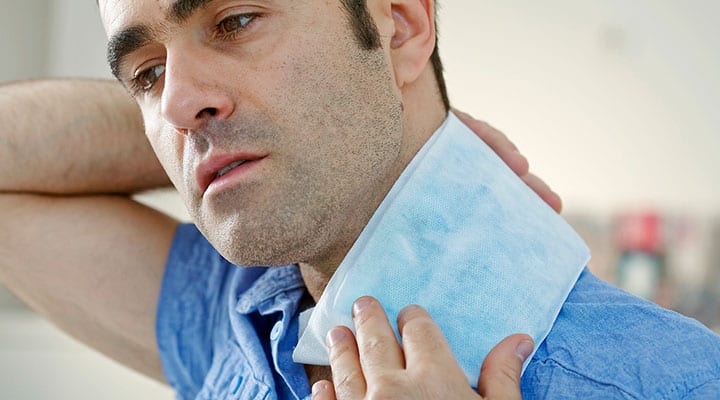
Benefits of Hot and Cold Therapy
Published: January 2024
Have you taken the plunge yet?
More and more people are immersing themselves in the ice-bath trend in hopes of reducing inflammation and speeding up the recovery process after a tough workout or injury. This type of treatment is called cold therapy, or cryotherapy. Cryotherapy has been practiced for centuries, much like its counterpart, thermotherapy (aka heat therapy).
While the two treatments are equally important for pain relief and muscle recovery, they work in very different ways. Whether you're trying to recover from overexertion or ease chronic low back pain, you need to know when to use what. Weekly ice baths or expensive cryotherapy chambers may or may not be the best thing for your body.
Keep reading, so you're not left high and dry—or cold and wet—for no reason.
What is hot and cold therapy?
Hot and cold therapy are exactly what the words imply, but let's explain them both a little further.
Heat therapy
Heat therapy increases the temperature of the area to which you apply it. The increased body temperature expands blood vessels (vasodilation) and promotes blood circulation. This is key for delivering oxygen and other necessary nutrients to the targeted area. The increase in temperature and blood flow also allows the musculoskeletal system to relax and move more fluidly.
There are two types of heat therapy:
Dry heat
—Sources of heat that do not require water or moisture, such as heating pads, heat packs, heat wraps and saunas. Dry heat therapy often requires a power source to maintain temperature, but not always.Moist heat
—Pain-relief methods that use hot water to stimulate and soothe muscle pain. Examples of moist heat therapy include steamed towels, hot water bottles, hot baths and steam baths.
Cold therapy
Have you ever heard of the R.I.C.E. method? This acronym stands for rest, ice, compression and elevation. This is a four-step protocol often used at the first sign of injury. Part of its effectiveness, of course, is the "ice" step, which simply involves applying ice to the injured area. Applying ice is a type of cold therapy treatment, and it works by using cold temperatures to lower the skin's temperature.
This drop in temperature makes blood vessels constrict (aka vasoconstriction), which reduces blood flow to the area. Even though it may sound counterproductive, reducing blood flow to an injured or overused area can actually help reduce inflammation, redness and swelling.
Cold therapy also works by reducing nerve activity, which can help with pain relief. Simply put, if your nerves aren't overly stimulated, the sensation of pain won't be nearly as strong.
Types of cold therapy include:
- Ice packs
- Ice baths
- Cold showers
- Topical cooling sprays, gels or creams
- Cold therapy chambers with sub-zero temperatures
Pro tip: Be careful not to mistake pain-relieving cryotherapy with the type used to remove abnormal tissue growth, such as warts. In the context of muscle recovery or acute injuries, cryotherapy simply refers to one of the cold therapy methods listed above.
What are the benefits of hot and cold therapy?
Heat therapy and cold therapy are both used to treat a variety of musculoskeletal ailments, or issues affecting muscles and bones.
Heat therapy has several notable benefits, including:
Pain relief
—At some point in your life, chances are that you will experience musculoskeletal pain. The level of pain can range from minor and temporary to chronic pain that's debilitating. Low back pain, for instance, affects millions of people each year and is a leading cause of disability. The good news is that heat treatment has been shown to alleviate some of that discomfort.Muscle stiffness
—There are many ways to support joint health and overall mobility, but heat therapy is probably the easiest. You don't have to break a sweat or invest in expensive equipment—drugstore heating pads are all you need. As previously mentioned, this type of treatment is extremely effective at increasing blood flow.Soft tissue flexibility
—A warmed-up body, muscle group or limb is more limber and flexible. But you have more warm-up choices than simply a couple of rounds of stretching or other exercises. Superficial heat can increase soft tissue flexibility, in part by increasing circulation. This can improve range of motion and prevent injuries, compared to beginning your workout without any warmup.Improved vascular health
—Research has shown that repeated heat therapy has benefits beyond pain relief, especially when it comes to vascular health—including overall improvements in arterial wall thickness, arterial stiffness and even flow-mediated dilation (when the artery dilates, and blood flow increases to that area).
But heat therapy shouldn't get all the glory! There are several benefits unique to cold therapy, too. Some of those benefits include:
- Reduced swelling and inflammation—Since the R.I.C.E. method was introduced in 1978, ice therapy has been a popular choice for reducing inflammation and relieving pain. But, of course, the research didn't rest. In one study, ice therapy reduced cytokines, compounds that can cause inflammation.
- Headache relief—Cryotherapy has been clinically proven to help treat migraine headaches. One randomized controlled trial confirmed that applying a frozen neck wrap at the onset of a migraine headache led to a significant reduction in the subject's reported pain, with participants receiving the cold pack treatment experiencing a 31.8% decrease in pain after 30 minutes. Those in the control group (those given a room temperature pack) reported a 31.5% increase in pain, indicating that the control did not stop or reduce pain from the oncoming migraine.
Another study showed that tension headaches can also be treated with cold therapy. Best of all, you don't need to use a freezing cold ice pack to get relief, with research finding that temperature at the upper range of normal cold applications could be more effective than long-term low temperatures.
- Optimized athletic performance—Wim Hof (aka "The Iceman") is known for the more recent resurgence in popularity when it comes to cold body therapy for athletes. In fact, it's one of the three pillars of his Wim Hof Method®, which also includes practicing breathing techniques and establishing a commitment to the routine.
Several professional athletes give partial credit for their performance to the addition of cold therapy. And that's not all. Scientific research has found that cold water immersion is an effective recovery method for strenuous exercise.
When should you use hot and cold therapy?
It is generally recommended to use ice for only the first few days after an injury. Use ice every 2 to 4 hours, but do not leave the injured area exposed to cold therapy for more than 20 minutes at a time. If your skin becomes numb, you may feel temporary pain relief—but really, the goal is to simply reduce inflammation and swelling. However, you don't want to divert blood flow for too long, as reduced blood flow can ultimately inhibit the recovery process.
This is where heat therapy comes into play. Once you resolve inflammation and swelling (usually within the first 24-72 hours post-injury), start applying heat for up to 20 minutes, three times per day. Heat therapy is especially helpful if used just before a bout of physical activity, or any form of movement that demands mobility of the affected area.
If you're not sidelined by an acute injury but your body is feeling sore and fatigued, this would be a good time to dig a little deeper. Start with a simple blood test. Athletic performance panels can uncover overtraining indicators, hydration status and even markers of inflammation. C-reactive protein (CRP), for instance, is the most relevant indicator of inflammation. Look for blood tests that assess your CRP levels, so you can better understand your need for hot or cold therapy.
When Should You Not Use Cold and Hot Therapy?
Despite the benefits of cold and hot therapy for different types of pain and recovery, there are a few things to be aware of for your safety before using these methods.
Never use heat or cold therapies on an open wound. Pregnant women should never apply ice or heat to their belly. Also, people with poor blood circulation or an impaired sensation of temperature—such as those with Raynaud's, diabetes or neuropathy—are advised to take extra precautions. If you can't feel the cold or heat, you may overexpose the affected area and cause long-lasting damage. And even if you have a perfect bill of health, limit your hot and cold exposure to 20-minute intervals. There really can be too much of a good thing.
Can you combine hot and cold therapy?
Yes! There is a time and place for alternating between hot and cold therapy—especially for regular gym-goers and performance athletes. A combination of heat therapy and cold therapy can help speed up recovery between training sessions. While scientific research is limited on the exact benefits, widespread and common usage suggests combining hot and cold therapy can help you get the most out of each and every workout.
Unfortunately, we don't really know if there is one "optimal" way to do combination therapy. Some recommend applying ice in the morning and heat at night. Others suggest applying heat for two minutes, followed by one minute of ice; and then repeating for three to six rounds. The timing pattern you choose is largely based on what best suits your lifestyle.
Personal preferences are also a factor. If you're concerned about inflammation, you may want to finish your healing sessions with cold therapy. On the other hand, ending with heat therapy makes your muscles feel loose and your nervous system feel totally zen.
Pro tip: When we talk about combination therapies, we're mostly talking about muscle recovery. When it comes to acute injuries, if you decide to use heat or warmth, make sure to use it for no longer than two to three minutes at a time, and always immediately follow it up with 30 seconds to a minute of cold. If you follow this method, you should always end with cold therapy. If you're unsure what to use and when, just sticking with conventional ice therapy is a good option for acute injuries.
How many times a week should you do hot and cold therapy?
With an acute injury, daily therapy is beneficial. Just remember to use cold therapy—and ONLY cold therapy—for the first 24 to 72 hours, or until swelling subsides. Then, switch exclusively to heat therapy to manage pain and promote mobility. If an acute injury is still bothering you after seven to ten days, see a doctor to address your healing needs further.
Combination therapy can also be used daily when you're enduring vigorous exercise five to seven days per week. Otherwise, hot and cold therapy can be used on an as-needed basis, or as directed by your healthcare provider.
References
- Cheng JL, MacDonald MJ. "Effect of heat stress on vascular outcomes in humans." J Appl Physiol (1985). March 2019. https://www.ncbi.nlm.nih.gov/pmc/articles/PMC6459390/
- Guillot X, et al. "Local ice cryotherapy decreases synovial interleukin 6, interleukin 1β, vascular endothelial growth factor, prostaglandin-E2, and nuclear factor kappa B p65 in human knee arthritis: a controlled study." Arthritis Res Ther. July 2019. https://pubmed.ncbi.nlm.nih.gov/31362785/
- Keillor J. "Using heat and cold for pain." Mayo Clinic. February 2021. https://connect.mayoclinic.org/blog/take-charge-healthy-aging/newsfeed-post/using-heat-and-cold-for-pain/
- Lepak LV. "Physical Rehabilitation, Chapter 7 – Localized Inflammation." 2007. https://www.sciencedirect.com/science/article/abs/pii/B9780721603612500107
- Meng W-J, et al. "Modification of therapeutic temperature range in cryotherapy could improve clinical efficacy in tension type headache." J Back Musculoskelet Rehabil. 2018. https://pubmed.ncbi.nlm.nih.gov/29562486/
- Moore E, et al. "Effects of Cold-Water Immersion Compared with Other Recovery Modalities on Athletic Performance Following Acute Strenuous Exercise in Physically Active Participants: A Systematic Review, Meta-Analysis, and Meta-Regression." Sports Medicine. December 2022. https://link.springer.com/article/10.1007/s40279-022-01800-1
- Sprouse-Blum AS, et al. "Randomized controlled trial: targeted neck cooling in the treatment of the migraine patient." Hawaii J Med Public Health. July 2013. https://www.ncbi.nlm.nih.gov/pmc/articles/PMC3727573/
- Wu A, et al. "Global low back pain prevalence and years lived with disability from 1990 to 2017: estimates from the Global Burden of Disease Study 2017." Ann Transl Med. March 2020. https://pubmed.ncbi.nlm.nih.gov/32355743/
- "Cryotherapy Cold Therapy for Pain Management." Johns Hopkins Medicine. https://www.hopkinsmedicine.org/health/treatment-tests-and-therapies/cryotherapy-cold-therapy-for-pain-management
- "Heat Therapy." ScienceDirect. https://www.sciencedirect.com/topics/nursing-and-health-professions/heat-therapy



